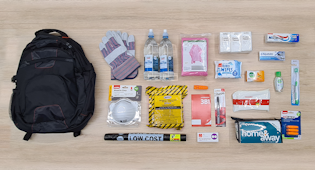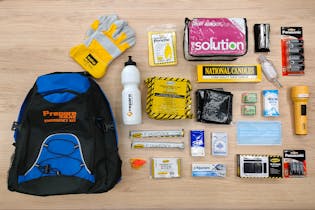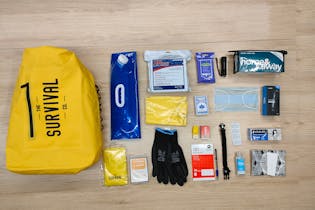What is an emergency grab bag? Will a commercially made one provide everything you need? Is it cheaper and better to make your own? We tested several commercial grab bags and compared them to our DIY kit.
Emergency grab bags are bags pre-packed with supplies that you’ll grab if you need to evacuate in an emergency. That might be due to a major earthquake, tsunami, volcanic eruption, severe storm, flood or fire.
Grab bags should hold the essentials you need for up to three days away from home.
If you have an evacuation shelter or community emergency hub near you, some of your needs might be provided – things like shelter, bed and water. But you’ll need to bring some things yourself and take care of all your needs on your way there, which could be a decent walk.
Key findings
- Overall, we think it’s best to build your own kit. Most of the pre-made grab bags in our test lack some key items or include gear that performs poorly. You can get better value for money building a customised grab bag, and you’ll be more familiar with what’s in it.
- Some of the pre-made grab bags deserve our recommendation and may suit if you want to save time and don’t mind spending a bit more.
- But even if you buy the best pre-made grab bag, you’ll need to add gear like clothing and personal supplies as recommended by the National Emergency Management Agency.
- Some of the grab bags we tested didn’t include a checklist of gear you need to add. Others included a list so long that you’d struggle to carry it all – you’d need a tramping pack of around 70 litres (not supplied).
- Most of the kits were supplied in small bags. **We think bigger backpacks are better (around 30–40 litres). That way, you can add warm clothing and personal items, and repack easily in a hurry if needed.
- Battery powered radios and torches are better than dynamo wind-up models. The dynamo torches in our test performed particularly badly, and Grab & Go’s radio performance was terrible.
Tips for building and storing your own grab bag
- Choose a backpack for your kit. They’re easy to carry, keeping your hands free.
- Go bigger than you think you need so you’ve got room to look for things without having to unpack the whole bag. A few different compartments will help organise gear.
- Make sure everybody in your household has their own grab bag. You’ll each need things specific to you, and you might need to evacuate at different times – for example, if one of you has a long journey home from work.
- Don’t overload your grab bag. While your bag should have the essentials you’ll need for a few days away from home, it must be comfortable to carry for a length of time.
- Two small water bottles are easier to carry than one large one. Commercially bottled water often lasts two years in storage. It’s not practical to carry the 9 litres of water you’d need for three days, but smaller bottles can be refilled as needed.
-
If filling pre-used water bottles, to avoid bacterial growth, make sure they’re clean and haven’t previously contained milk or
other dairy products. Fill them right to the top to keep air out.
Chlorinated tap water should last a year in storage with good
preparation.
- If using unchlorinated water, add water purification tablets or drops (as directed on the pack) to keep it safe for drinking. Don’t use household bleach products, as some contain fragrances and detergents not shown in the ingredients list, and they’re not safe in drinking water.
- Choose battery powered torch and radio. They perform much better than wind-up models. Wind-up models also often have NiMH batteries that stop working well when stored long-term without regular use and charging.
- A headlamp is more practical than a torch. You’ll have both hands free for tasks.
- Choose lithium or alkaline batteries with a long shelf life. Don’t buy carbon zinc. Check out our AA disposable batteries test results to find out which batteries are best and where to find the expiry dates. The information applies to AAA batteries too.
- Go for masks that are rated P2 or N95. They filter out more particles than P1 masks, offering better protection from toxic dust and ash (eg, following an earthquake or volcanic eruption) and some viruses.
- Not all commercial first aid kits are good. If you’re buying a pre-made one, make sure it has a good range of wound dressings, including large ones, plus other essentials. Some large kits are full of small plasters and thin bandages that won’t help with bigger injuries.
- For warm clothing, choose merino, wool, polyester or polypropylene products. Cotton-based clothing like jeans, hoodies and t-shirts will make you cold if they get wet or damp with sweat.
- Avoid flame products like candles and matches. Battery powered lighting is safer, particularly during earthquakes and aftershocks.
- Store your grab bags somewhere they’re easy to grab for a quick exit.
- Consider keeping a kit at work too and adding a blanket in case you need to spend a few nights – following a major earthquake, for example. It’s also wise to store extra water with your work kit (9 litres or more).
- Update your grab bags, other emergency kits and plans yearly. Water, food, batteries and some first aid items expire. And you’ll need extra supplies if more people or animals join your household or if anyone’s needs change. Your emergency plan may need updating too if you move house or workplace.
We were able to build a comprehensive kit of good quality for $160. If you’re using our DIY kit as a guide to build your own emergency grab bag, don’t forget to add your essential extras such as clothing, personal items and cash.
Why is this free?
This report is free thanks to funding from the National Emergency Management Agency (NEMA) and Toka Tū Ake EQC.
We've tested several emergency grab bags and made one of our own. Find out how they compare.


